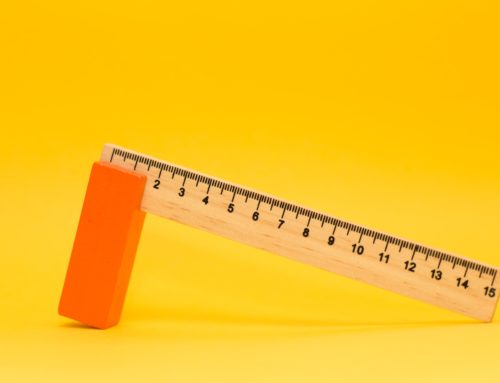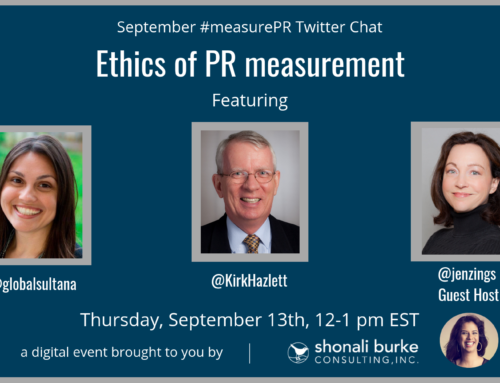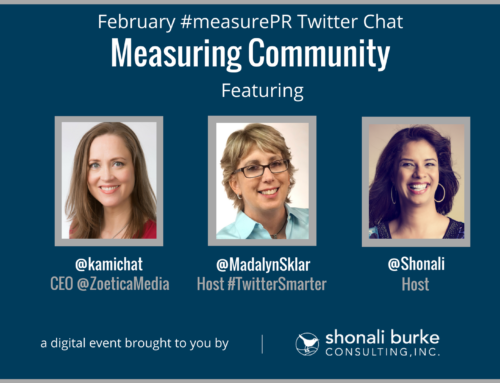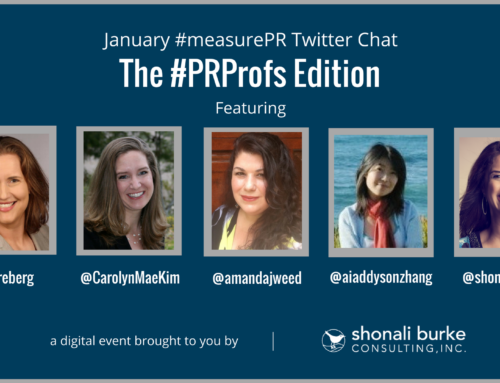 Guest Post by Emma Hawes
Guest Post by Emma Hawes
Measurement, in my opinion, is the most misunderstood element of public relations. The reason I chose public relations as a career is because it involves creating and implementing communication plans that facilitate change.
However, any goal needs a purpose. Measurement shows if you are influencing people to change their behaviors.
Measurement is evidence that you care for your organization.
Measurement has been confusing to me since the beginning.
During the “Introduction to PR” course I took as an undergrad, I was introduced to RPIE, which means research, planning, implementation and evaluation. The word “measurement” became a substitute for evaluation. It seemed to prove more action to me during this phase.
Recently, I started grading my own work so I can at least see when I need to improve.
Strategy is important, but it must include measurement. So, for example, while strategizing communications around domestic abuse, we might look for statistics such as a 10% increase in women who left an abusive relationship, to support that strategy.
Rethinking my measurement efforts
After my Social PR Makeover, I saw that my overall measurement efforts had a lot of positives, but also some negatives.
My biggest flaw is getting so caught up in my work that I lose track of the “why.” So, recalling the purpose of the campaign is the most insightful thing I do.
When I hit writer’s block, I tell myself something like:
“Em, this campaign you are creating will help kids with childhood cancer. These kids are miles away from home in a hospital. They are not attending school or extracurricular activities with friends.”
That description is morbid to me, but it helps me realize that a campaign is going to cause change. It’s so important to stay focused and create benchmarks for yourself so that you can measure the results of your efforts.
So, for example, while working with Delta Zeta Sorority, I try to stay focused on two things: the girls who show tremendous efforts for fundraising with Hearts For Hearing, and the amount of money they have raised for Heart for Hearing.
The beauty of public relations is that it allows people from diverse backgrounds to come together.
In every team, there are people who are named the key graphic designer, photographer, writer, strategist and metrics analyst. However, we must educate ourselves in all these areas – so that we can do the best for our clients.
A writer must listen to the analyst to make the campaign better.
Trust me, I’m someone who is willing to design visual content all day long, but my efforts are nothing without research. To motivate myself with metrics, I remind myself that I was horrible at Illustrator just two years ago.
So if I could improve on that, I can learn metrics as well.
Just like anything in life, don’t let metrics bring you down.
Google Analytics is still an ugly monster to me, but I will not let that destroy my passion for public relations. I’m aware I’m not the only one with that concern.
Even if you can’t tackle the monster at least show some effort.
I have a little bit of knowledge about it, but it never hurts to know more.
Instead of binge watching shows, I’m going to watch videos for the Google Analytics Academy. After six units of instructional videos and activities, I will take a final assessment to obtain a certificate of completion. I don’t care if the course takes six or 60 hours, because we all need to invest in our strengths as well as our weaknesses.
Step back for a while to measure, evaluate, and most importantly take pride in your work. That’s one thing that we forget too often.
It’s important to remember that views on social media points don’t really matter, nor the amount of likes. What’s important is learning how to measure the impacts on our campaigns, and achieving what we initially set out to do.
Image via Emma Hawes, Used with permission








Great job on this post, Emma. It definitely takes more than just numbers to see the whole picture. :)
Thanks Tressa, I had to write about it because it is so easy to lose sight of what you do.